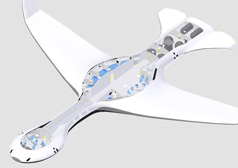 135k
135k
 141k
141k
| Length | 48m |
|---|---|
| Width | 49.5m |
| Empty Weight | 68479kg |
| Maximum Weight | 131229kg |
| Story Weight | 120000kg |
Quita's ship is designed for interstellar travel. It can accommodate a crew of 5 with 2 additional passengers for up to 6 months at a time. It can operate in atmospheres and land on dry surfaces. It carries a variety of science equipment including a 1.2m telescope and can accommodate small to medium sized live and inert samples. It doesn't have artificial gravity, but does have a faster than light drive.
The ship has two types of propulsion.
The interstellar drive operates on the principle of local/remote volume exchange. It exchanges the contents within a 47m radius around the drive with the contents of an identical volume anywhere from 178 km to 1.041 billion km away. The jump is instantaneous and can't be felt or heard. Jumps can be made as frequently as once every 0.6 seconds allowing for a travel rate of up to 1.51 light years / hour. Energy spent is not related to the distance traveled
The jump accuracy is not perfect. Location errors can be as high 939km per jump so errors accumulate pretty rapidly for long distances.
The drive can change the ship's location, but not it's momentum. Upon arrival, regular Newtonian thrust will be required to change the ship's velocity to match its destination. Accounting for differences in star motion, planet motion, and ship motion, this difference can be over 100,000 m/s, but is usually much less. When Albert Einstein rewrote the laws of motion, the laws of momentum survived. I figure if momentum can survive Einstein, who am I to change it?
This drive, of course, is pure fantasy. There is no faster than light travel. If there was, such a drive could be used to change potential energy and, therefore, create energy. I don't believe this is really possible. Energy can be created from matter (E=mc2), but not from nothing!
The second propulsion type is based on observed physical laws. It's what I like to call a momentum engine. These engines work by ejecting mass at high velocity. The higher momentum of the expelled material (mass time it's velocity), the greater the acceleration for the ship. The problem momentum engines have is the ship has to carry the fuel that gets ejected. A heavy ship can't accelerate as much.
All we really care about is the momentum. Less mass ejected at a higher velocity yields the same momentum, but with a lighter ship. The trick is to speed up the ejection as much as practical. Quita's ship uses a principle similar to that of particle accelerators. It uses very powerful magnetic fields to eject a relatively small amount of iron to provide thrust. It gets its energy from fusion reactors that split water and fuse the hydrogen atoms into helium atoms.
Quita's ship literally runs on water and iron dust! I choose iron because it has minimal impact on biology when introduced into an environment, is relatively common, and responds well to magnetic fields even when cold.
There are two main momentum engines in the rear, two gimbaled engines below for hovering, and several small engines to provide attitude adjustment in space.
With no anti-gravity, there are two remaining ways for the ship to land. It can accelerate to match a planet's velocity very closely and then gently descend to the landing site, or spend less fuel and use atmosphere friction to help slow it down. Like Earth reentry vehicles, a heat shield protects it during rapid entries. In my story, Quita and her ship mates choose the latter option so they get a ride to Earth very similar to what our astronauts experience.
Copyright © 2017-2018 by David White
This page last updated 24-Jan-2018